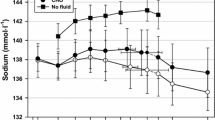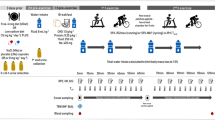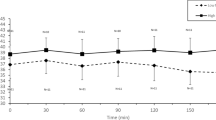Abstract
Hypokinesia (diminished movement) induces significant potassium (K) changes; however, little is known about K deposition and deficiency during hypokinesia (HK). Using K supplements during and after HK, the aim was to establish body K deposition and K deficiency during HK. Studies were done during the pre-HK period of 30 d, HK period of 364 d, and post-HK period of 30 d. Forty male trained athletes aged 24.9 ± 8.0 y were chosen as subjects. They were equally divided into four groups: unsupplemented active control subjects (UACS), unsupplemented hypokinetic subjects (UHKS), supplemented active control subjects (SACS), and supplemented hypokinetic subjects (SHKS). Hypokinetic subjects were limited to an average walking distance of 0.7 km/d. Control subjects ran an average distance of 11.6 km/d. The SHKS and SACS groups took 95.0 mg elemental K/kg body weight daily.
Fecal K excretion, urinary sodium (Na) and K excretion, plasma K and Na levels, plasma renin activity (PRA), plasma aldosterone (PA), food and fluid intake, and physical characteristics were measured. During HK, fecal K loss, urinary K and Na loss, and plasma K, Na, PRA, and PA levels increased significantly (p ≤ 0.05), whereas during the initial days of post-HK, the levels of the measured parameters decreased significantly (p ≤ 0.05) in the SHKS and UHKS groups as compared with the SACS and UACS groups, respectively. During HK, body weight, body fat, peak oxygen uptake, food and fluid intake decreased significantly (p ≤ 0.05), whereas during the initial days of post-HK period remained significantly (p ≤ 0.05) depressed and fluid intake increased in SHKS and UHKS groups when compared with the SACS and UACS groups, respectively. However, during HK and post-HK plasma, urinary, and fecal K changed significantly (p ≤ 0.05) more in the SHKS group than in the UHKS group. The deposition of K was significantly (p ≤ 0.05) lower and K deficiency much higher in the SHKS group than in the UHKS group. Fecal K loss, urinary K and Na loss, plasma K, Na, PRA, and PA levels, body weight, body fat, peak oxygen uptake, and food and fluid intake did not change significantly in the SACS and UACS when compared with their baseline control values.
It was shown that plasma K concentration and urinary and fecal K excretion increased during HK and decreased significantly (p ≤ 0.05) during post-HK. post-HK. Oral K supplements did not influence plasma or fecal and urinary K either during HK or post-HK. It was concluded that the low plasma K level and fecal and urinary K loss during post-HK may indicate the presence of K deficiency, and increased K in plasma, urine, and feces during HK and in the presence of K deficiency may suggest the body’s inability to retain K during HK.
Similar content being viewed by others
References
I. V. Fedorov and L. A. Grishanina, Nitrogen metabolism in animals exposed to hypodynamia, Kosmichesk. Biol. 1, 43–48 (1967).
I. V. Fedorov, V. N. Vinogradov, Yu. I. Milov, and L. A. Grishanina, Synthesis of tissue proteins in animals during hypodynamia, Kosmichesk. Biol. 4, 18–21 (1970).
I. V. Fedorov, A. V. Chernyy, and A. I. Fedorov, Synthesis and catabolism of tissue proteins in animals during hypodynamia and resumption of muscular activity, Fiziol. Zh. SSSR 63, 1128–1133 (1977).
Y. G. Zorbas, G. E. Verentsov, and Y. F. Federenko, Renal excretion of end products of protein metabolism in urine of endurance trained subjects during restriction of muscular activity, Panminerva Med. 37, 109–114 (1995).
Y. G. Zorbas, V. J. Kakurin, V. B. Afonin, N. A. Kuznetsov, V. L., Yarullin, and S. D. Denogradov, Potassium loading effect on potassium balance in athletes during prolonged restriction of muscular activity, Biol. Trace Element Res. 70, 1–19 (1999).
V. P. Krotov, Kinetics and regulation of fluid and electrolytes metabolism in animals and human beings during prolonged hypokinesia, Ph.D. thesis, “Interkosmos” Council, Academy of Sciences USSR and Directorate of Kosmic Biology and Medicine, Ministry of Health USSR, Moscow (1978).
Y. G. Zorbas, V. J. Kakurin, N. A. Kuznetsov, V. L. Yarullin, I. D. Andreyev, and K. P. Charapakhin, Measurements in calcium supplemented athletes during and after hypokinetic and ambulatory conditions, Clin. Biochem. 33, 393–404 (2000).
Y. G. Zorbas, Y. Y. Yaroshenko, N. K. Kuznetsov, S. N. Madvedev, and Y. F. Federenko, Electrolyte concentration in skeletal muscles and plasma of rats during and after exposure to hypokinesia and hyperhydration, Physiol. Chem. Phys. Med. NMR 29, 243–259 (1997).
Y. G. Zorbas, V. J. Kakurin, V. B. Afonin, K. P. Charapakhin, V. L. Yarullin, and V. A. Deogenov, Calcium measurements in calcium supplemented primates during and after hypokinesia in establishing calcium deficiency during prolonged hypokinesia, Biol. Trace Element Res. 76, 113–131 (2000).
J. H. Lohman, A. F. Roche, and R. Martorell (eds.), Anthropometric Standardization Reference Manual, Human Kinetics, Champaign, IL, 1988.
J. Brozek, F. Grande, J. T,. Anderson, and A. Keys, Densitometric analysis o body composition, Ann. NY Acad. Sci. 110, 113–140 (1963).
Yu. P. Ryl’nikov, Hypokinetic effect on the lipid composition of blood and tissues of rabbits of different age, Kosmichesk. Biol. 8, 8–13 (1974).
T. N. Lobova and A. V. Chernyy, Effect of physical loads on some parameters of lipid and carbohydrate metabolism during hypokinesia, Kosmichesk. Biol. 11, 36–40 (1977).
Y. G. Zorbas, A. L. Ivanov, and M. F. Fukuhara, Blood and lipids metabolism in rats under hypokinesia, Mater. Med. Polona. 22, 275–279 (1990).
Y. G. Zorbas, V. J. Kakurin, K. P. Charapakhin, V. L. Yarullin, S. D. Denogradov, and V. A. Deogenov, Measurements in magnesium supplemented athletes during and after hypokinetic and ambulatory conditions, Magnes. Bull., in press.
Y. Rayssiguier, E. Gueux, and D. Weiser, Effect of magnesium deficiency on lipid metabolism in rats fed a high carbohydrate diet, J. Nutr. 11, 1876–1883 (1981).
V. A. Tishler, V. M. Zatsiorskiy, and V. N. Seluyanov, Study of mass-inertia characteristics of human body segments during six month hypokinesia, Kosmichesk. Biol. 15, 36–42 (1989).
Y. G. Zorbas, V. R. Bobylev, and A. N. Naexu, Physical exercise in preserving mens body mass under hypokinesia, Int. J. Rehab. Res. 12, 326–330 (1989).
Y. G. Zorbas, V. R. Bobylev, A. N. Marketi, and Y. F. Federenko, Body mass changes in endurance trained volunteers during prolonged restriction of muscular activity and chronic hyperhydration, Sports Med. Training Rehab. 4, 167–176 (1993).
Ye. V. Gushevas and R. Yu. Tashpulatov, Effect of flights of differing duration on protein composition of cosmonauts blood, Kosmichesk. Biol. 14, 13–17 (1980).
Ye. V. Gushevas and R. Y. Tashpulatov, Investigation of albumin and globulin composition of blood of the crew of Salyut-3 Station, Kosmichesk. Biol. 13, 15–18 (1979).
Y. G. Zorbas, Y. Y. Yaroshenko, O. L. Georgeascu, and M. N. Tanaka, Haemoglobin mass in men after hypokinesia and physical exercise with chronic hyperhydration, Model. Simul. Control 21, 43–56 (1990).
P. A. Deuster, E. Dolev, S. B. Kyle, R. A. Anderson, and E. B. Schoomaker, Magnesium homeostasis during high-intensity anaerobic exercise in men, J. Appl. Physiol. 62, 545–550 (1987).
H. C. Lukaski, W. W. Bolonchuk, L. M. Klevay, D. B. Milne, and H. H. Sandstead, Maximal oxygen consumption as related to magnesium, copper and zinc nutrients, Am. J. Clin. Nutr. 37, 407–415 (1983).
Y. G. Zorbas, Y. F. Federenko, and Ch. N. Saito, Endogenous parathyroid hormone and renal excretion of magnesium in endurance trained volunteers during prolonged restriction of muscular activity, Magnes. Bull. 16, 104–112 (1994).
Y. G. Zorbas, A. K. Kakurin, N. K. Kuznetsov, M. A. Federov, Y. Y. Yaroshenko, and V. L. Yarullin, Magnesium loading effect on magnesium deficiency in endurance trained subjects during prolonged restriction of muscular activity, Biol. Trace Element Res. 61, 222–233 (1998).
Y. G. Zorbas and I. O. Matvedev, Man’s desirability in performing physical exercises under hypokinesia, Int. J. Rehab. Res. 9, 170–174 (1986).
Y. G. Zorbas, I. O. Matvedev, and V. R. Bobylev, Men’s working capacity under hypokinesia and physical exercise, Model. Simul. Control 18, 37–50 (1989).
Author information
Authors and Affiliations
Rights and permissions
About this article
Cite this article
Zorbas, Y.G., Kakurin, V.J., Kuznetsov, N.A. et al. Measurements in potassium-supplemented athletes during and after hypokinetic and ambulatory conditions. Biol Trace Elem Res 85, 1–22 (2002). https://doi.org/10.1385/BTER:85:1:01
Received:
Accepted:
Issue Date:
DOI: https://doi.org/10.1385/BTER:85:1:01




